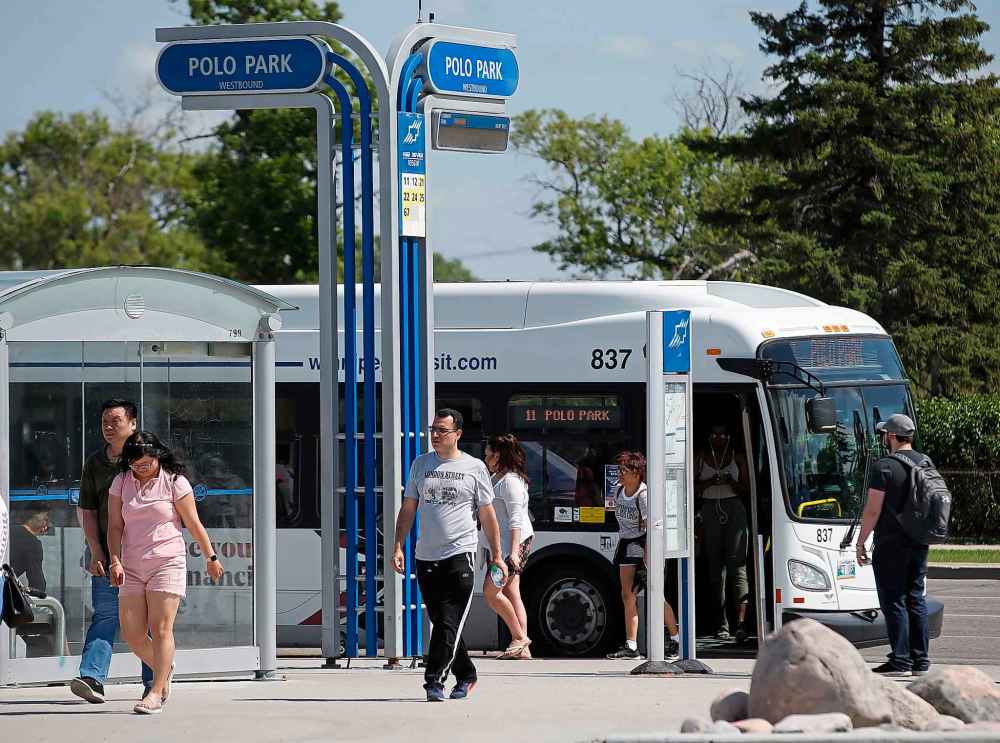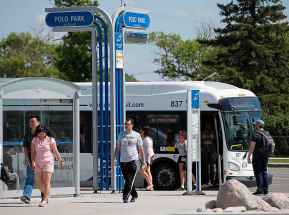Missed your bus? Chances are you’re not alone There's a 43 per cent chance of your bus not being on time: report
Read this article for free:
or
Already have an account? Log in here »
To continue reading, please subscribe:
Monthly Digital Subscription
$19 $0 for the first 4 weeks*
- Enjoy unlimited reading on winnipegfreepress.com
- Read the E-Edition, our digital replica newspaper
- Access News Break, our award-winning app
- Play interactive puzzles
*No charge for 4 weeks then billed as $19 every four weeks (new subscribers and qualified returning subscribers only). Cancel anytime.
Read unlimited articles for free today:
or
Already have an account? Log in here »
Hey there, time traveller!
This article was published 01/07/2019 (1907 days ago), so information in it may no longer be current.
There’s a 43 per cent chance any City of Winnipeg bus will arrive early or late, according to new data released by Winnipeg Transit.
During the afternoon rush hour — 4 p.m. to 6:30 p.m. — 56 per cent of buses are not on time. Transit defines a bus as "late" if it arrives three minutes or more after it is supposed to and "early" if it arrives one minute or more before schedule.
Transit released a trove of run time information to the city’s website Friday.
“It’s not stellar, but we’re constantly working to improve it," manager of Transit service development Bjorn Radstrom said Tuesday. "I’m a big believer in transparency, whether it makes us look good or not."
Perhaps not surprisingly, the time of year when buses were least likely to be on time was in winter. There were nine days in February when all buses were more likely to be late than on time; on Feb. 4, 2019, 71 per cent of buses were late.

wfpremovefromapp:
!function(e,t,s,i){var n=”InfogramEmbeds”,o=e.getElementsByTagName(“script”)[0],d=/^http:/.test(e.location)?”http:”:”https:”;if(/^/{2}/.test(i)&&(i=d+i),window[n]&&window[n].initialized)window[n].process&&window[n].process();else if(!e.getElementById(s)){var r=e.createElement(“script”);r.async=1,r.id=s,r.src=i,o.parentNode.insertBefore(r,o)}}(document,0,”infogram-async”,”https://e.infogram.com/js/dist/embed-loader-min.js”);
:wfpremovefromapp
Being early or late is only part of the challenge of maintaining an efficient network of buses. Sometimes, Winnipeg buses are full and unable to pick up waiting passengers, a situation known to Transit officials as "pass-ups."
For example, up to five times a day on routes Nos. 75 and 162, would-be passengers watch as the bus arrives but doesn’t stop because it’s already full or because the vehicle can’t accommodate bikes, strollers, or wheelchairs, Radstrom said.

wfpremovefromapp:
!function(e,t,s,i){var n=”InfogramEmbeds”,o=e.getElementsByTagName(“script”)[0],d=/^http:/.test(e.location)?”http:”:”https:”;if(/^/{2}/.test(i)&&(i=d+i),window[n]&&window[n].initialized)window[n].process&&window[n].process();else if(!e.getElementById(s)){var r=e.createElement(“script”);r.async=1,r.id=s,r.src=i,o.parentNode.insertBefore(r,o)}}(document,0,”infogram-async”,”https://e.infogram.com/js/dist/embed-loader-min.js”);
:wfpremovefromapp
On route No. 16, 111 wheelchair users get passed up every year, according to Transit — though Radstrom notes those numbers have improved in recent years as the service has phased out inaccessible buses.
!function(e,t,s,i){var n=”InfogramEmbeds”,o=e.getElementsByTagName(“script”)[0],d=/^http:/.test(e.location)?”http:”:”https:”;if(/^/{2}/.test(i)&&(i=d+i),window[n]&&window[n].initialized)window[n].process&&window[n].process();else if(!e.getElementById(s)){var r=e.createElement(“script”);r.async=1,r.id=s,r.src=i,o.parentNode.insertBefore(r,o)}}(document,0,”infogram-async”,”https://e.infogram.com/js/dist/embed-loader-min.js”);
Radstrom said he rides his bike in the summer, but takes the bus all winter — so he knows what it’s like to watch a bus go by early or to wait in -40 C.
“I can feel their pain,” he said. “I understand how frustrating it is when a bus isn’t on schedule. So that’s why I’m trying to make this work, to see how we can improve this.”
Radstrom said the city has been using the data to alter bus routes to be as accurate as possible, with a team of four full-time schedule rewriters. For the fall, they’re releasing new schedules for routes Nos. 16, 19 and 28.
“The whole system here, it really is broken. When you look at the public, everyday people that are trying to get to work and back, what kind of message does that send?”–Union president Aleem Chaudhary
“It’s a long and very involved process,” Radstrom said. “For each three-month scheduling period, we can only get through rewriting a handful of routes. And even then, that’s only the first iteration. We need to rewrite each of them a couple of times.”
While it is slow-going now, such work will be delayed in future years as the team focuses on shifting schedules when the Southwest Transitway rapid-bus route comes online.
"Imagine what it would be like if we weren’t doing this work. It would be far, far worse," Radstrom said.
The city’s dump of data was released amid ongoing contract talks with Amalgamated Transit Union Local 1505 (which represents Transit drivers and mechanics) — and schedules have been a sticking point.

Union president Aleem Chaudhary said ATU has been trying to get this data for years, because late buses put drivers at risk — not only because of the stress of trying to adhere to a tight schedule, but also because angry riders make things difficult for drivers.
“Buses are always late, and it’s very, very difficult for our operators to keep buses on schedule because the schedules are so tight,” Chaudhary said.
“The whole system here, it really is broken,” he said. “When you look at the public, everyday people that are trying to get to work and back, what kind of message does that send?”
He said he is outraged the rate of wheelchair pass-ups continues to be so high. “It just doesn’t jive at all, what they’re saying… We have to save Winnipeg Transit from itself.”
Pass-ups spike in September and again, to a lesser extent in January, according to the Transit. Radstrom ascribed it to post-secondary students figuring out their schedules and, unfortunately, there’s not a solution, other than to keep crunching the numbers.

wfpremovefromapp:
!function(e,t,s,i){var n=”InfogramEmbeds”,o=e.getElementsByTagName(“script”)[0],d=/^http:/.test(e.location)?”http:”:”https:”;if(/^/{2}/.test(i)&&(i=d+i),window[n]&&window[n].initialized)window[n].process&&window[n].process();else if(!e.getElementById(s)){var r=e.createElement(“script”);r.async=1,r.id=s,r.src=i,o.parentNode.insertBefore(r,o)}}(document,0,”infogram-async”,”https://e.infogram.com/js/dist/embed-loader-min.js”);
:wfpremovefromapp
“There’s no such thing as being done,” he said. “By the time we get back to the beginning, we’ll be due for another rewrite.”
The buses least likely to be on time are routes Nos. 57, 39 and 163 — more than 60 per cent of the time they’re either early or late, the Transit numbers show.
tessa.vanderhart@freepress.mb.ca
Twitter: @tessavanderhart










